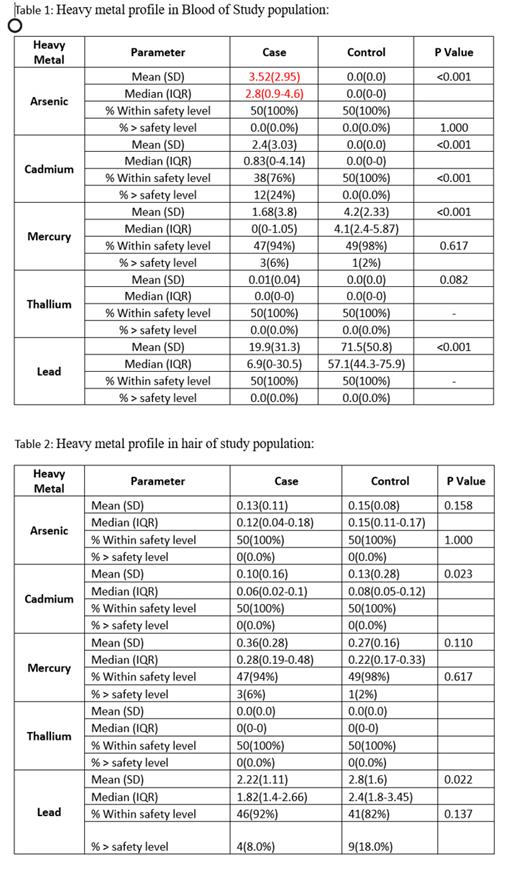Introduction:Compared to western world the incidence of AA in South Asian countries is higher. There are studies to suggest that incidence of this disease is 2-3 times higher in LMICs. Besides immune mediated pathophysiology and inherited presdispostion, toxic insult to the hematopoietic elements due to chemotherapy, radiation exposure, drugs,and environmental toxins such as pesticides and heavy metals have been associated with Aplastic Anemia.The higher incidence of AA in lower socio-economic status and its association with drinking water habits, industrial exposure suggests a possible link with heavy metals in the pathogenesis of disease.
Methodology:Fifty patients diagnosed with idiopathic aplastic anaemia and 50 age and gender matched healthy controls were included in the study. 2 ml of blood and 20 hair shafts were collected as samples from each subject for the analysis of arsenic, lead, cadmium, mercury, and thallium in both samples by Inductively Coupled Plasma Mass Spectrometry (ICP-MS).
Results:The total study population consisted of 61 males and 39 females. 42% of the cases were residents of rural areas, and 58% belonged to urban areas. 54% participants among the controls belonged to rural areas. Among the total population, 48% cases and 58% controls were using tap water as major source of water. Out of the total participant in the study, 10% of the cases and 12% of the controls were found to be exposed to pesticides previously, however no direct occupational exposure of heavy metal was found among the study population. Twenty-three patients (46%) had NSAA, and 15 patients had SAA (30%) while 12 patients (24%) had VSAA.Mean values of arsenic in blood of patients and controls are 3.52±2.9mcg/L,and 0.0mcg/L respectively and the difference was statistically significant (p <0.001) however the mean arsenic values in hair of cases and controls were not different significantly(0.13±0.1mg/g and 0.15±0.1mg/g;p=0.16).Mean values of cadmium in blood of patients and controls were 2.5±1.9mcg/L and 0 mcg/L (p <0.001). Mean values of cadmium in hair of patients and controls are 0.10±0.16, 0.13±0.28 respectively.We noticed blood cadmium higher than safer limits in 24% of cases none in the controls.We found 6% of cases had higher than permissible limit of mercury level and 8% of cases have higher than permissible limit of lead level in their hair samples which represent chronic exposure.
Conclusion:
We found higher mean values of blood Arsenic and blood Cadmium in cases compared to controls. Upto one fourth cases had higher than safety levels of cadmium in their blood. Although causal association cannot be determined in this study our results indicate that heavy metal toxicity may be one of the reasons for AA in regions with higher environmental exposure and soil and water contamination.
Disclosures
No relevant conflicts of interest to declare.


This feature is available to Subscribers Only
Sign In or Create an Account Close Modal